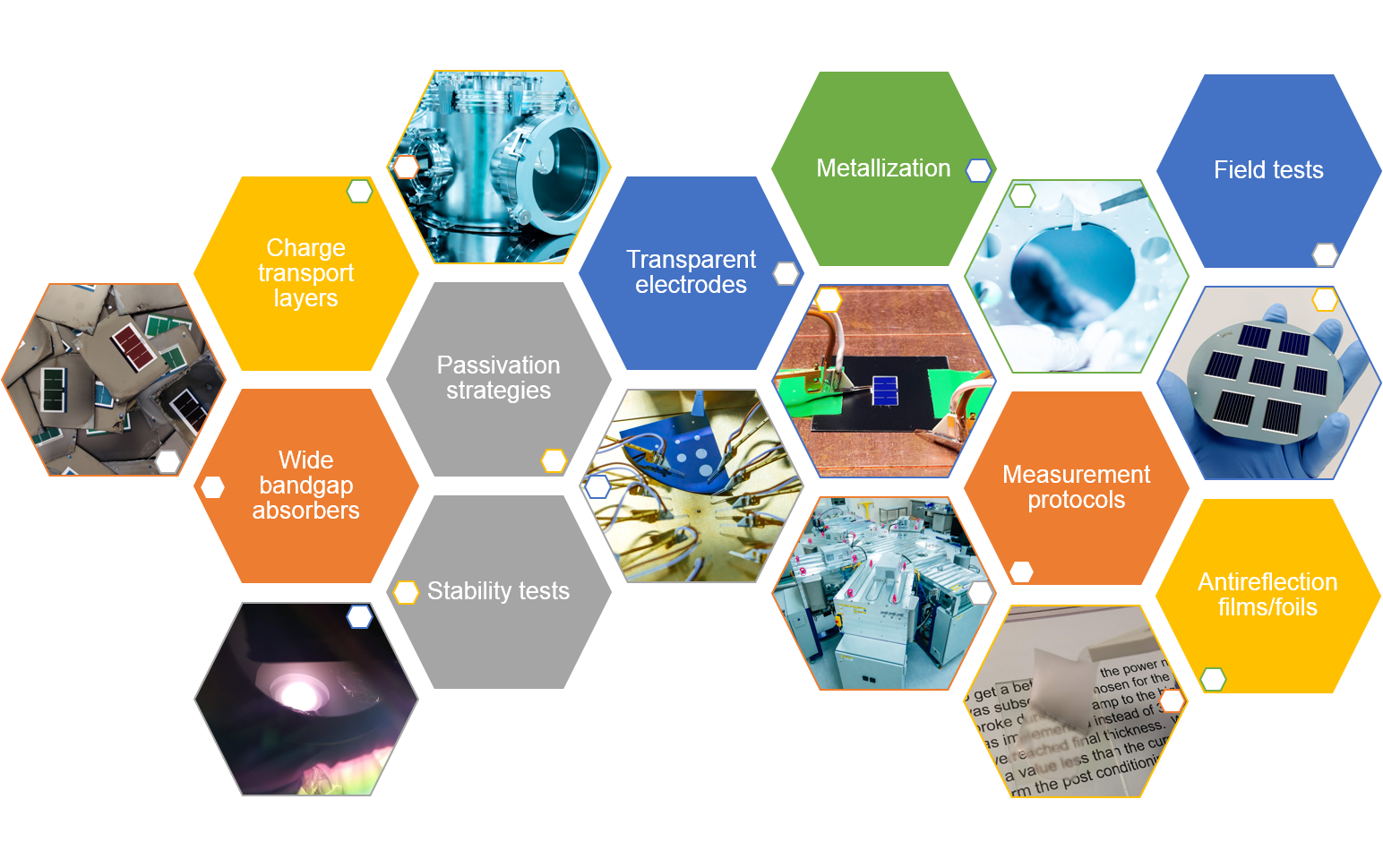

Research Details
The current global photovoltaics market (nowadays taken for more than 90% by crystalline silicon solar cells) has seen sustained growth of its production capacity by more than 20% annually. From a longer-term perspective, the market is expected to make a transition towards ultra-high efficiencies. For this, further efficiency improvement s will be needed, beyond the single-junction efficiency limit of silicon (which is 29.4 %) [2]. The most straightforward way to do so is in the form of a silicon-based tandem solar cell, where a wider-bandgap top cell overlays the silicon bottom cell.
In perovskite/silicon tandem solar cells, the perovskite top cell efficiently harvests the blue part of the solar spectrum, while transmitting the red part, which is absorbed in the silicon bottom cell. In this way, the tandems can overcome the single-junction efficiency limit of silicon solar cells.
Realistic industrial applications require upscaling the perovskite top-cell technology, compared to the current lab standard. These top cells should then be monolithically integrated onto standard, textured SHJ cells in so-called two-terminal tandem solar cells. Such monolithic integration implies that the top cell needs to be deposited directly on top of the bottom cell (see Figure 2.b). An important consequence of such a monolithic tandem configuration is the fact that the two subcells must be designed to generate a similar photocurrent under maximum-power-point operation, else the total current density of the tandem device will be limited by lower current density, leading to lower performance. This current matching requirement limits the ideal top cell bandgap to a narrow range of Eg ≈1.7–1.8 eV while silicon has Eg ≈ 1.1 eV . From this perspective, perovskite solar cells are attractive top-cell candidates: Essentially, this is a thin-film photovoltaic technology using relatively wide bandgap absorbers and remarkable optoelectronic properties (such a sharp absorption onset and relatively long carrier diffusion lengths). In its single-junction configuration, deposited on glass, efficiencies above 23% have now been reported. [4] Monolithic tandem devices, using SHJ solar cells have also already been reported, with efficiencies >25%. [5] Moreover, with compositional engineering, the bandgap of the perovskite absorbers can be opened further, into the range that is ideal for top cell applications.
In the KPV-LAB, we develop perovskite-silicon tandem solar cells targeting efficiency beyond the single-junction limits of silicon solar cells. We are developing optimal bandgap perovskite absorbers as well as minimizing the parasitic absorption losses originating from carrier selective contacts and transparent electrodes. Besides, we are developing novel charge transport layers and contact passivation schemes. We are exploring thermal evaporation techniques and hybrid techniques to fabricate perovskite solar cells on textured silicon solar cells and scaling up.

Related Publications
This study, which took place in Joule, demonstrates a simple additive strategy to suppress halide segregation. Here, we demonstrate 28.2%-efficient and stable perovskite/Si monolithic tandem solar cells
This study demonstrates 27%-efficient perovskite/silicon tandem solar cells in n–i–p configuration by developing novel electron and hole selective contacts, which combine high broadband transparency with efficient charge extraction. This study took place in the June issue of Energy & Environmental Science.
This study, which was recently published in Joule, reports a concurrent cationic and anionic perovskite defect passivation strategy using the phenformin hydrochloride molecule boosting the performance of monolithic perovskite/silicon tandem solar cells.
In this publication, which took place in Nature Energy, we investigate the influence of scattered and reflected light from the ground (albedo) on the performance of the bifacial tandems with different perovskite bandgaps.
This paper, published in Materials Horizons, reviews the state-of-the-art recombination junction which has been used for perovskite-based tandems and explains the fundamental working principles behind it.
This study, which took place in Nature Energy, show that a lower bandgap perovskite than needed at standard test conditions is actually beneficial to perovskite/silicon tandem cells in the field.
This study, published in ACS Energy Letters, reports one of the highest PCE for single-junction devices fabricated by lost die coating as well as showing the first example of slot-die coated perovskite/silicon tandems on textured interfaces.
This study shows 28.2% lab-scale mechanically stacked perovskite/silicon tandem solar cells in collaboration with Sargent Group from the University of Toronto - published in Nature Communications
Growing perovskite on textured silicon - this report published in Science demonstrates the solution-processed perovskites on textured c-Si bottom cells in tandem configuration. Textured interfaces enable improved light coupling and efficient charge extraction and result in 25.7% certified monolithic tandem solar cells.
This study demonstrates the potential usage of the spray deposited perovskite nanocrystal inks for perovskite/silicon tandem solar cells.
This study unveils the potential of the Zr‐doped indium oxide (IZRO) transparent electrodes for perovskite-based tandem solar cells due to its very high electron mobility (up to ≈77 cm2 V−1 s−1), highly infrared transparency and very low sheet resistance (≈18 Ω ohm/sq)